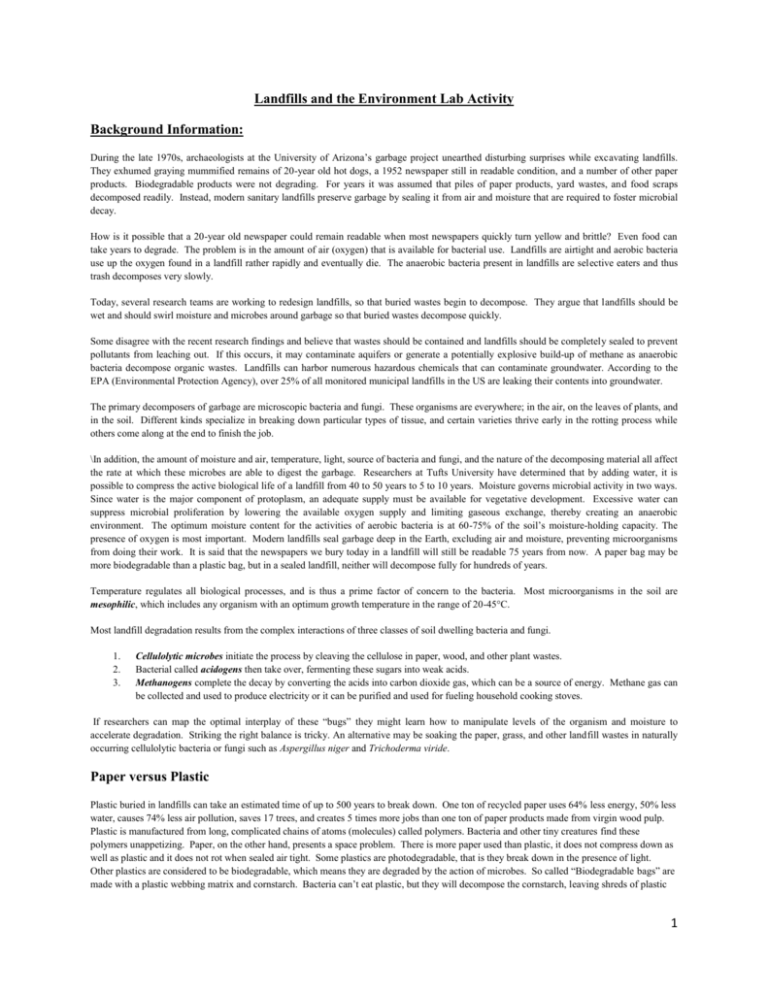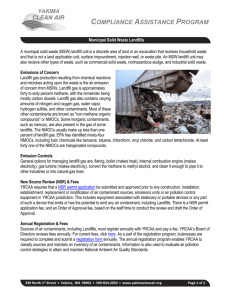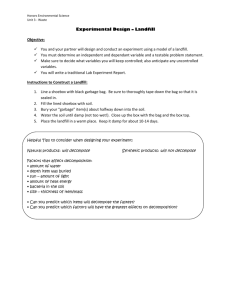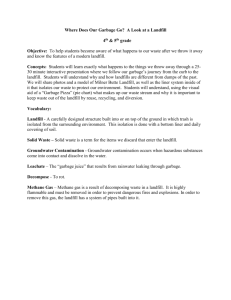Landfills and the Environment Lab Activity Background Information
advertisement

Landfills and the Environment Lab Activity Background Information: During the late 1970s, archaeologists at the University of Arizona’s garbage project unearthed disturbing surprises while excavating landfills. They exhumed graying mummified remains of 20-year old hot dogs, a 1952 newspaper still in readable condition, and a number of other paper products. Biodegradable products were not degrading. For years it was assumed that piles of paper products, yard wastes, and food scraps decomposed readily. Instead, modern sanitary landfills preserve garbage by sealing it from air and moisture that are required to foster microbial decay. How is it possible that a 20-year old newspaper could remain readable when most newspapers quickly turn yellow and brittle? Even food can take years to degrade. The problem is in the amount of air (oxygen) that is available for bacterial use. Landfills are airtight and aerobic bacteria use up the oxygen found in a landfill rather rapidly and eventually die. The anaerobic bacteria present in landfills are selective eaters and thus trash decomposes very slowly. Today, several research teams are working to redesign landfills, so that buried wastes begin to decompose. They argue that landfills should be wet and should swirl moisture and microbes around garbage so that buried wastes decompose quickly. Some disagree with the recent research findings and believe that wastes should be contained and landfills should be completely sealed to prevent pollutants from leaching out. If this occurs, it may contaminate aquifers or generate a potentially explosive build-up of methane as anaerobic bacteria decompose organic wastes. Landfills can harbor numerous hazardous chemicals that can contaminate groundwater. According to the EPA (Environmental Protection Agency), over 25% of all monitored municipal landfills in the US are leaking their contents into groundwater. The primary decomposers of garbage are microscopic bacteria and fungi. These organisms are everywhere; in the air, on the leaves of plants, and in the soil. Different kinds specialize in breaking down particular types of tissue, and certain varieties thrive early in the rotting process while others come along at the end to finish the job. \In addition, the amount of moisture and air, temperature, light, source of bacteria and fungi, and the nature of the decomposing material all affect the rate at which these microbes are able to digest the garbage. Researchers at Tufts University have determined that by adding water, it is possible to compress the active biological life of a landfill from 40 to 50 years to 5 to 10 years. Moisture governs microbial activity in two ways. Since water is the major component of protoplasm, an adequate supply must be available for vegetative development. Excessive water can suppress microbial proliferation by lowering the available oxygen supply and limiting gaseous exchange, thereby creating an anaerobic environment. The optimum moisture content for the activities of aerobic bacteria is at 60-75% of the soil’s moisture-holding capacity. The presence of oxygen is most important. Modern landfills seal garbage deep in the Earth, excluding air and moisture, preventing microorganisms from doing their work. It is said that the newspapers we bury today in a landfill will still be readable 75 years from now. A paper bag may be more biodegradable than a plastic bag, but in a sealed landfill, neither will decompose fully for hundreds of years. Temperature regulates all biological processes, and is thus a prime factor of concern to the bacteria. Most microorganisms in the soil are mesophilic, which includes any organism with an optimum growth temperature in the range of 20-45°C. Most landfill degradation results from the complex interactions of three classes of soil dwelling bacteria and fungi. 1. 2. 3. Cellulolytic microbes initiate the process by cleaving the cellulose in paper, wood, and other plant wastes. Bacterial called acidogens then take over, fermenting these sugars into weak acids. Methanogens complete the decay by converting the acids into carbon dioxide gas, which can be a source of energy. Methane gas can be collected and used to produce electricity or it can be purified and used for fueling household cooking stoves. If researchers can map the optimal interplay of these “bugs” they might learn how to manipulate levels of the organism and moisture to accelerate degradation. Striking the right balance is tricky. An alternative may be soaking the paper, grass, and other landfill wastes in naturally occurring cellulolytic bacteria or fungi such as Aspergillus niger and Trichoderma viride. Paper versus Plastic Plastic buried in landfills can take an estimated time of up to 500 years to break down. One ton of recycled paper uses 64% less energy, 50% less water, causes 74% less air pollution, saves 17 trees, and creates 5 times more jobs than one ton of paper products made from virgin wood pulp. Plastic is manufactured from long, complicated chains of atoms (molecules) called polymers. Bacteria and other tiny creatures find these polymers unappetizing. Paper, on the other hand, presents a space problem. There is more paper used than plastic, it does not compress down as well as plastic and it does not rot when sealed air tight. Some plastics are photodegradable, that is they break down in the presence of light. Other plastics are considered to be biodegradable, which means they are degraded by the action of microbes. So called “Biodegradable bags” are made with a plastic webbing matrix and cornstarch. Bacteria can’t eat plastic, but they will decompose the cornstarch, leaving shreds of plastic 1 behind. The idea of biodegradable plastic tends to be misleading because it gives the impression that these new bags will vanish after they are thrown away. Bacteria need more than biodegradable material, they need oxygen and moisture that a landfill is not able to provide long-term. Therefore, garbage layers near the top of a landfill may degrade, but layers at the bottom probably won’t degrade even if the material is degradable. The amount of waste generated by the US in 1986 was over 91 million tons. By the year 1998 that number exceeded 220 million tons. Since 1990, the percentage of waste that is recycled in the US has increased at a steady rate. Unfortunately, the human population is growing at a greater rate, overshadowing any gains that may have been realized. During the 1950s, a popular trend evolved called “throwaway living” that promised to cut down on tedious chores; today, packaging material alone amounts to over 50 million tons of the waste. Because we are running out of landfills, America now faces a big garbage problem. In the next 20 years over ¾ of the landfills in the US will shut down. Some will close because of health and safety regulations, others because they’ve reached their capacity. By 2010, there won’t be many places for our trash to go. Other problems associated with landfills include waste that is toxic, not biodegradable, or both. New York City alone, throws out enough garbage each day to fill the Empire State Building. A modern sanitary landfill is designed to protect the environment from pollution and thus it is completely sealed. Water in a landfill dissolves pollutants out of the garbage, forming a solution known as leachate. To prevent this leachate from contaminating the groundwater, the landfill space is lined with a layer of clay covered by a heavy synthetic liner made out of plastic or rubber., The leachate is pumped up from the bottom of the landfill and stored in tanks prior to processing. When the landfill is full, it is covered with layers of clay, sand, and topsoil, and then vegetation is planted to absorb the rainfall that can form leachate. In fact, some landfills are planned to provide recreational facilities, such as parks and playgrounds, when they are completely filled and secured. In addition, methane produce in the landfill may be used to generate electricity very efficiently. In the area immediately surrounding the landfill, groundwater monitoring wells are used to determine whether the leachate is flowing into the groundwater Sanitary Landfill Open Landfill 2 Inquiry into Landfills This is an inquiry lab, in which you will attempt to hypothesize and investigate the optimum environment that encourages degradation of materials in a landfill. Each lab group is going to set up its own “mini” landfill system that you will be following for the next six weeks. You will get containers (number to be determined by your group) to simulate the boundaries of your landfill, and a plastic liner to be used to simulate the liner present in landfills. You will have access to sand, and topsoil, and/or soil from the outdoor environment of your choice. Your group will choose a variable you wish to test to determine the optimum environment that encourages degradation of materials in a landfill. Variables to think about: Light Temperature Darkness Amount of moisture Type of soils Wind Presence of O2 in lower layers of landfill Your group will build its landfill using any or all of the materials listed below: Materials Available: Newspaper Refrigerator Synthetic fibers Soil drying oven/incubator Plastic strips Heat lamp Dried plant material Light Biodegradable plastic strips Mini fan Wood Bread Eggshells Vegetable/fruit waste Straws Styrofoam Any other organic material you wish to bring from home, except meat or dairy products Day One: Read background information, prepare for pre-lab formative assessment next class Day Two: Formative assessment In your group, begin to design your lab. o First, what question are you investigating? Choose your variable. Write it down in your journal. o Hypothesize about what you expect to happen o Design your landfill IN YOUR JOURNAL (do a cross section) o Get me to approve your final plan Day Three: Set up your experimental landfill/s, and design your data table. Things to think about: o What types of data will you collect…qualitative or quantitative? Try to design an experiment that allows you to collect quantitative data. Don’t forget experimental design! o Day Four-End Collect data 3 Analysis Questions 1. 2. 3. 4. 5. Hypothesize about how the soil you used influenced the degradation of the materials you put in your landfill. When did you first start to notice signs of degradation? Which materials seemed to decompose most quickly? Which materials seemed resistant to decomposition? Think of the design of your landfill. How would you improve your landfill model to make it more effective? What would you change or add to enhance its ability to most effectively degrade waste materials? Define each of the following, and describe any that you observed over the course of this lab. a. Biodegradation b. Photodegradation c. Leachate d. Sanitary landfill Find any alternative method of dealing with waste materials. Design a double bubble thinking map to compare and contrast that method with sanitary landfills. Don’t forget to do error analysis, and a reflection! 4









![Job Description [DOCX - 46 KB]](http://s3.studylib.net/store/data/006796150_1-234d988c32268468d66802e573122cf6-300x300.png)